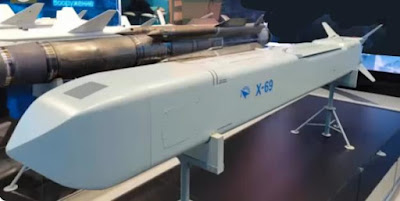The Kh69 missile was designed and developed by MKB Raduga for the Russian Air Force. The X-69 prototype of this land-attack cruise missile underwent flight tests between 2019 and 2022, entering service in 2023. Since then it has been produced in large numbers. It is an air-to-surface autonomous weapon which is launched from Sukhoi Su-30SM, Su-34M, and Su-57 combat aircraft.
The Kh 69 is a low-visibility, land-attack cruise missile conceived for high-precision, non-nuclear strikes deep in enemy territory against various ground-based targets, such as command post bunkers, energy facilities, ammunition depots, troops concentration, and telecommunication centers. It employs identified coordinates prior to the launch and it is guided by GLONASS, which is the Russian satellite navigation system, and inertial navigation, which utilizes motion and rotatation (gyroscope) sensors to calcularte the position.
The Kh-69 missile is fitted with a four-fin tail and folding wings, which spread out as soon as the missile is dropped from aircraft. Its body is not cylindrical but square-shaped, with a pyramidal nose. It is armed with a 310-kg high explosive/ penetrating cumulative warhead. Although it flies at subsonic speeds, it is virtually invisible to enemy radar, as it has a low-visibility profile, is covered by special coating material, and flies very low over the ground, being made of improved composite materials.
Specifications
Type: air-to-surface, land-attack, cruise missile
Length: 4.19 m
Wing Span: 2.45 m
Body Side: 30 cm (0.30 m)
Weight: 770 kg
Warhead: 310 kg
Engine: turbojet
Speed: 780-1,000 km/h
Range: up to 400 km
Below, schematic of the Kh-69 missile, with all the data.
Photo of missile in a weapons exhibition in Moscow in 2023.





No comments